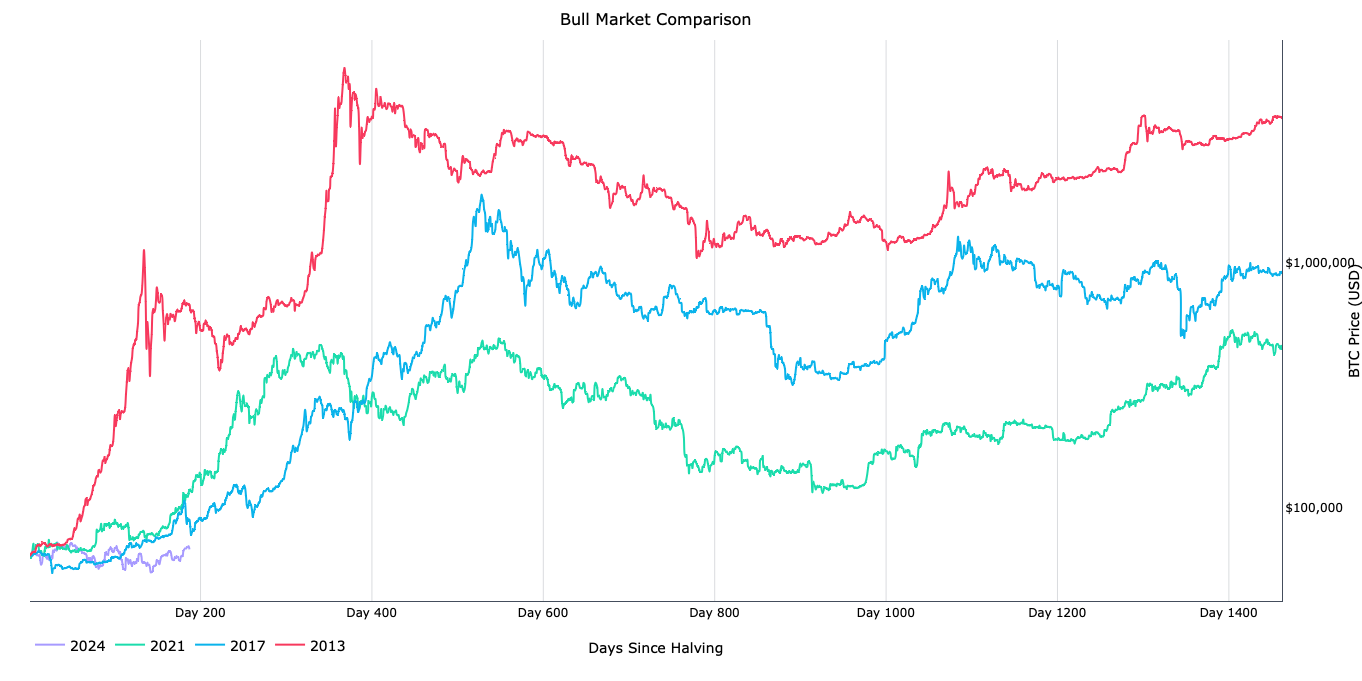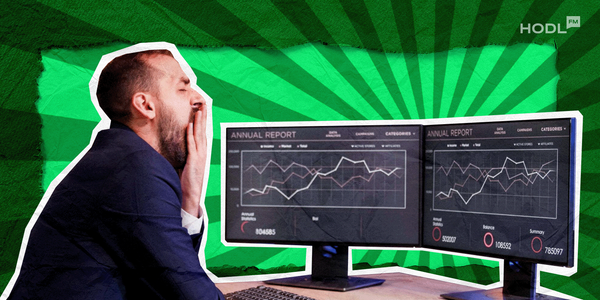A crypto bull run is a period of rapid and significant price increases in Bitcoin and other cryptocurrencies, often characterized by skyrocketing values as they bounce back from previous lows and hit new all-time highs. During these bullish phases, investor confidence soars, creating widespread excitement and attracting attention from mainstream investors, retail traders, and media outlets alike.
In this article, we explore the definition of a crypto bull run, examine the key factors that trigger such markets, highlight notable past examples, and discuss the potential risks associated with these explosive growth periods.
Bull run vibes 🌝
by u/TheCheese2024 in dogecoin
Current Market Analysis: Key Indicators and Sentiment
In the past, the start of a crypto bull market has often been marked by increasing Bitcoin dominance, a metric that measures the market value of BTC to the total crypto market cap.
In a typical market situation, a BTC rally will precede gains across the wider crypto market. After getting buoyed by profitable opportunities offered by the largest cryptocurrencies, Bitcoin and Ethereum, investors now ventured into altcoins and other high-risk digital assets such as memecoins. This activity also captures news outlets which continue covering the price movements, and folks in traditional investors start analyzing existing and upcoming cryptocurrencies.
We observed this trend during the 2021 - 2022 bull market where an uptick in altcoin performance was preceded by impressive bitcoin gains.

In 2024, the increasing BTC dominance exhibited a similar pattern with previous bull markets. The rise in dominance seems to have paved the way for altcoin rallies, however, there were other factors to the current bull run that had not previously been present during past events.
These include the rise of spot Bitcoin ETF inflows, the rise of meme token creation platforms and enhanced onchain liquidity.
Other tell-tale signs of a crypto bull market include surging total active addresses, which represents user engagement or the number of unique addresses that are conducting crypto transactions within a specified period.
During market upticks, there’s usually a significant increase in active addresses, thus signifying high market engagement. This happened during the 2017 bull market when we witnessed consistently rising active addresses across the Bitcoin network. Blockchain insights platforms such as CoinMetrics and Glassnode.
Whale accumulation is another tell-tale sign of a crypto bull market. Once you notice whales start accumulating, it may often signal the market is approaching a bottom and the investors are confident it could rise from there.
Timeline and Economic Factors
A crypto bull market doesn’t just happen. Usually, it’s the culmination of several key factors that lead to increasing prices, investor confidence and market excitement. Here are some of them:
- Institutional investment in crypto: The crypto market can achieve significant prices when big institutions or publicly traded companies begin accumulating digital assets. It’s usually a strong signal that the space is gaining mainstream legitimacy. At the same time, institutional money increases liquidity and creates more demand. Institutional involvement was one of the primary drivers of the 2020 - 2021 bull market, when the likes of MicroStrategy and Tesla started piling up bitcoin.
- Bitcoin halving effects: The Bitcoin halving event is one of the most significant factors that triggers a crypto bull market by cutting down the supply of new BTC into the market by 50%. With supply down, scarcity sets in and demand grows stronger thereby increasing the price of bitcoin. The last halving event occurred in April 2024, and it did buoy the broader market into positive gains.
- Positive news: Positive news plays a role in boosting investor and retail traders’ confidence and excitement, because it makes them more likely to buy and hodl assets. Some of the news could be optimistic regulatory news, major partnerships, major economics embracing digital assets, big partnerships, and key opinion leaders/influencers endorsing the space.
what is your Bet for the next all time high Bull Run ?
by u/luisMax1991 in Bitcoin
Historical Context: Past Crypto Bull Runs and Triggers
Retail investors’ frenzy in 2017
2017 was Bitcoin’s first bull market and a pivotal point in the history of crypto. It’s when the price of BTC skyrocketed from $1,000 and reached $20,000.
Adoption by retail investors was this bull market’s key driver, many of whom entered the space through Initial Coin Offerings (ICO).
Ethereum, which had just been launched two years prior, made a valuable contribution to the industry and its ICO laid the groundwork of numerous other ICOs. However, the initial crypto bull run wasnt that sustainable and within a year, the market crashed into a crypto winter that lasted till 2021, Bitcoin price dropped by approximately 80%.
Institutional and Mainstream Adoption in 2020 and 2021
In 2020 and 2021, Bitcoin’s bull market made a comeback, and this time it wasn’t just fueled by FOMO and memes like 2017.
Nope, some big shots entered the party—Tesla, MicroStrategy, and Square—all rolling in their fat wallets, buying up Bitcoin like it was their last slice of pizza.
The decentralized finance (DeFi) and Non-fungible tokens (NFTs) space had just emerged, introducing strong interest and plenty of liquidity into the space.
This bull run also coincided with the pandemic where people were working from home, buying online, economic stimulus and falling interest rates across traditional investments. All these factors culminated into the bull market of 2020 and 2021, with BTC reaching a high of $69,000.
Some of the characterics of the 2017 bull market was more maturity compared to the previous one, more regulatory clarity and increased adoption of the blockchain across several sectors.
The Role of Macroeconomic Factors in Crypto and Federal Reserve Actions
There are wider economic factors that often play a vital role in strengthening the price of cryptocurrencies or helping with Bitcoin price predictions. These could be inflation, lending interests, alternative assets and geopolitical factors.
Expansion and recession indicate the health of the global economy. During recession, people lack sufficient wealth to allocate to alternative assets, however, expansion strengthens economic prosperity and people have extra wealth to invest in digital assets.
According to ex-Bitmex CEO Arthur Hayes crypto predictions, the rising cost of energy and increasingly rampant inflation in the Middle East could send us into new bull territory.
Dynamics and Investor Sentiment
Investor sentiment is a crucial indicator of Bitcoin dynamics and cryptocurrency market trends. Read on to see how they can help guage the performance of digital assets and how you can conduct your own market sentiment analysis.
The Fear and Greed Index
The Fear and Greed Index offers a snapshot of market emotions by analyzing insights such as market volume, social media activity and volatility.
In periods of extreme fear, the market is approaching a bottom. Extreme greed on the other hand signals a market top.
Investors want to gauge when fear in the market is reaching its highest, which could suggest the bottom. Platforms that provide insights about market sentiment include Santiment and Alternative.me.
Stablecoins
Stablecoins such as USDT and USDC are the chill cousins of crypto, tied to fiat currencies for the sake of maintaining stability across crypto’s volatile world.
High volume of stablecoins means people are playing safe or preparing to enter new positions. However, you’ve got to zoom out and check the entire market.
Google Trends
Google Trends allows us to guage public interest by tracking down search metrics to see what related terms are people interested in at a particular period.
Interpreting Google Trends will involve looking at how people are searching for ‘Bitcoin’ Ethereum or related terms. High search volumes often suggest strong public interest, and may signal a potential uptick in prices. However, a metric like search interest needs to be combined with other indicators to get quality estimates.
At the close of 2017, search interest on Google for the term ‘Bitcoin’ reached an all-time high. The increasing search volume suggested surging mainstream interest and investor excitement. In 2021, popular altcoins, the likes of Dogecoin, experienced massive spikes in search interest which had corelations with the astronomical price gains of these altcoins.
Final Take
Investors and retail traders need to get a grip on market tops and bottoms if they want to explore the digital assets space without feeling like they're lost in a maze. Sure, keeping track of all the metrics that point to Bitcoin cycles can feel like a wild goose chase, but the payoff is worth it.
Understanding the market’s ups and downs helps you assess risk, get a clearer view of crypto’s future, and conduct solid due diligence.
Plus, who wouldn’t want to be the person who saw the market dip before everyone else.

Disclaimer: All materials on this site are for informational purposes only. None of the material should be interpreted as investment advice. Please note that despite the nature of much of the material created and hosted on this website, HODL FM is not a financial reference resource and the opinions of authors and other contributors are their own and should not be taken as financial advice. If you require advice of this sort, HODL FM strongly recommends contacting a qualified industry professional.




